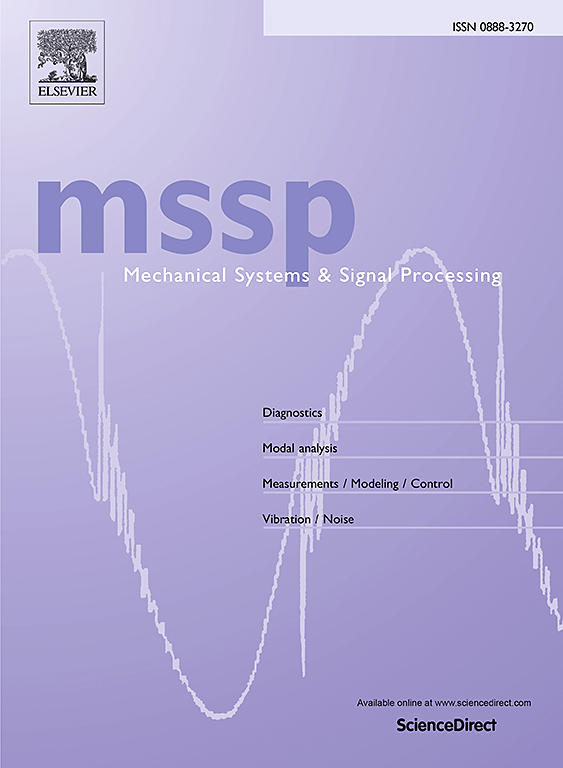悬架螺旋弹簧弹性波操纵:轮胎声腔共振降噪机制与控制策略
IF 8.9
1区 工程技术
Q1 ENGINEERING, MECHANICAL
引用次数: 0
摘要
开发既能有效抑制道路噪音,又不影响车辆动力学的螺旋弹簧,尤其是操纵稳定性和乘坐舒适性,这是一项关键的工程挑战。针对结构传递道路噪声(SBRN)的主要峰值来源——轮胎声腔共振(TACR)噪声,提出了以微幅振动控制SBRN的最小结构改造策略。本文为螺旋对称梁提供了独特的弹性波传播模型,以支持对振动响应的物理认识。波的特性对比分析表明,具有高负群速的低阶准传播波具有全向和局域传播特征。这些波的散射衰减是由螺旋构型的几何折叠引起的,表明了关键弹簧几何形状的明显参数依赖性。具体而言,减小导线直径和增大螺旋半径可以增强NGV准传播波的衰减带和衰减,而优化弹簧倾角可以扩大主振动区,从而减小末端振动输出。这些波具有低共振和高可调性,共振边带与TACR波段匹配度高。此外,广泛应用的波型匹配和空间优势响应匹配的阻尼优化策略显著提高了振动抑制效果。总体而言,本工作建立了一个集数值方法、弹性波操纵机制、振动优化策略和实验验证为一体的螺旋弹簧动力学设计框架,为中低频TACR降噪提供了科学指导。本文章由计算机程序翻译,如有差异,请以英文原文为准。

Elastic wave manipulation in suspension helical spring: Mechanisms and control strategies for tire acoustic cavity resonance noise mitigation
Developing helical springs that effectively suppress road noise without compromising the vehicle dynamics, particularly handling stability and ride comfort, poses a critical engineering challenge. To address tire acoustic cavity resonance (TACR) noise, a primary peak contribution of structure-borne road noise (SBRN), minimal structural modification strategies to control SBRN with micro-amplitude vibration are proposed. This paper provides unique elastic wave propagation models for helically symmetric beams to support the physical insight into vibration response. Comparative analysis of wave behavior shows that low-order quasi-propagating waves with high negative group velocity (NGV) exhibit omnidirectional and localized propagation characteristics. The scattering attenuation of these waves, resulting from geometric folding in helical configurations, demonstrates pronounced parametric dependencies on key spring geometry. Specifically, reducing wire diameter and increasing helix radius can enhance the attenuation band and attenuation of NGV quasi-propagating waves, while optimizing spring inclination angle may expand the primary vibration zone, thereby reducing the end vibration output. The low-level resonance and high tunability of these waves have resonance sidebands with high matching with the TACR band. Furthermore, damping optimization strategies of widely applicable wave mode matching and spatially advantageous response matching significantly improve vibration suppression. Overall, this work establishes a comprehensive dynamic design framework for helical springs that integrates numerical methods, elastic wave manipulation mechanisms, vibration optimization strategies, and experimental verification, offering scientific guidance for medium–low frequency TACR noise mitigation.
求助全文
通过发布文献求助,成功后即可免费获取论文全文。
去求助
来源期刊

Mechanical Systems and Signal Processing
工程技术-工程:机械
CiteScore
14.80
自引率
13.10%
发文量
1183
审稿时长
5.4 months
期刊介绍:
Journal Name: Mechanical Systems and Signal Processing (MSSP)
Interdisciplinary Focus:
Mechanical, Aerospace, and Civil Engineering
Purpose:Reporting scientific advancements of the highest quality
Arising from new techniques in sensing, instrumentation, signal processing, modelling, and control of dynamic systems
 求助内容:
求助内容: 应助结果提醒方式:
应助结果提醒方式:


